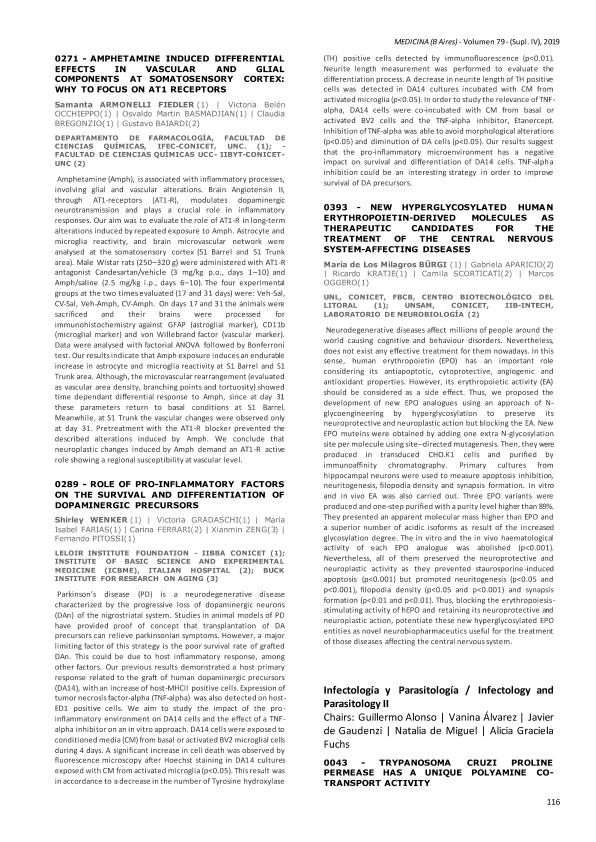Evento
Amphetamine induced differential effects in vascular and glial components at somatosensory cortex: Why to focus on AT1 receptors
Armonelli Fiedler, Samanta ; Occhieppo, Victoria Belen
; Occhieppo, Victoria Belen ; Basmadjian, Osvaldo Martin
; Basmadjian, Osvaldo Martin ; Bregonzio Diaz, Claudia
; Bregonzio Diaz, Claudia ; Baiardi, Gustavo Carlos
; Baiardi, Gustavo Carlos
 ; Occhieppo, Victoria Belen
; Occhieppo, Victoria Belen ; Basmadjian, Osvaldo Martin
; Basmadjian, Osvaldo Martin ; Bregonzio Diaz, Claudia
; Bregonzio Diaz, Claudia ; Baiardi, Gustavo Carlos
; Baiardi, Gustavo Carlos
Colaboradores:
Costas, Monica Alejandra ; Marino, Gabriela Inés
; Marino, Gabriela Inés ; Azurmendi, Pablo Javier
; Azurmendi, Pablo Javier
 ; Marino, Gabriela Inés
; Marino, Gabriela Inés ; Azurmendi, Pablo Javier
; Azurmendi, Pablo Javier
Tipo del evento:
Reunión
Nombre del evento:
LXIV Reunión Anual de la Sociedad Argentina de Investigación Clínica; LI Reunión Anual de la Asociación Argentina de Farmacología Experimental; XXI Reunión Anual de la Sociedad Argentina de Biología; XXXI Reunión Anual de la Sociedad Argentina de Protozoología y IX Reunión Anual de la Asociación Argentina de Nanomedicinas
Fecha del evento:
13/11/2019
Institución Organizadora:
Sociedad Argentina de Investigación Clínica;
Asociación Argentina de Farmacología Experimental;
Sociedad Argentina de Biología;
Sociedad Argentina de Protozoología;
Asociación Argentina de Nanomedicinas;
Asociación Argentina de Ciencia y Tecnología de Animales de Laboratorio;
Título de la revista:
Medicina (Buenos Aires)
Editorial:
Fundación Revista Medicina
ISSN:
0025-7680
e-ISSN:
1669-9106
Idioma:
Inglés
Clasificación temática:
Resumen
Amphetamine (Amph), is associated with inflammatory processes, involving glial and vascular alterations. Brain Angiotensin II, through AT1-receptors (AT1-R), modulates dopaminergic neurotransmission and plays a crucial role in inflammatory responses. Our aim was to evaluate the role of AT1-R in long-term alterations induced by repeated exposure to Amph. Astrocyte and microglia reactivity, and brain microvascular network were analysed at the somatosensory cortex (S1 Barrel and S1 Trunk area). Male Wistar rats (250–320 g) were administered with AT1-R antagonist Candesartan/vehicle (3 mg/kg p.o., days 1–10) and Amph/saline (2.5 mg/kg i.p., days 6–10). The four experimental groups at the two times evaluated (17 and 31 days) were: Veh-Sal, CV-Sal, Veh-Amph, CV-Amph. On days 17 and 31 the animals were sacrificed and their brains were processed for immunohistochemistry against GFAP (astroglial marker), CD11b (microglial marker) and von Willebrand factor (vascular marker). Data were analysed with factorial ANOVA followed by Bonferroni test. Our results indicate that Amph exposure induces an endurable increase in astrocyte and microglia reactivity at S1 Barrel and S1 Trunk area. Although, the microvascular rearrangement (evaluated as vascular area density, branching points and tortuosity) showed time dependant differential response to Amph, since at day 31 these parameters return to basal conditions at S1 Barrel. Meanwhile, at S1 Trunk the vascular changes were observed only at day 31. Pretreatment with the AT1-R blocker prevented the described alterations induced by Amph. We conclude that neuroplastic changes induced by Amph demand an AT1-R active role showing a regional susceptibility at vascular level.
Palabras clave:
AT1 receptors
,
Amphetamine
,
Brain vasculature
,
Astroglia
,
Microglia
Archivos asociados
Licencia
Identificadores
Colecciones
Eventos(IFEC)
Eventos de INST. DE FARMACOLOGIA EXPERIMENTAL DE CORDOBA
Eventos de INST. DE FARMACOLOGIA EXPERIMENTAL DE CORDOBA
Eventos(IIBYT)
Eventos de INSTITUTO DE INVESTIGACIONES BIOLOGICAS Y TECNOLOGICAS
Eventos de INSTITUTO DE INVESTIGACIONES BIOLOGICAS Y TECNOLOGICAS
Citación
Amphetamine induced differential effects in vascular and glial components at somatosensory cortex: Why to focus on AT1 receptors; LXIV Reunión Anual de la Sociedad Argentina de Investigación Clínica; LI Reunión Anual de la Asociación Argentina de Farmacología Experimental; XXI Reunión Anual de la Sociedad Argentina de Biología; XXXI Reunión Anual de la Sociedad Argentina de Protozoología y IX Reunión Anual de la Asociación Argentina de Nanomedicinas; Mar del Plata; Argentina; 2019; 115-115
Compartir



